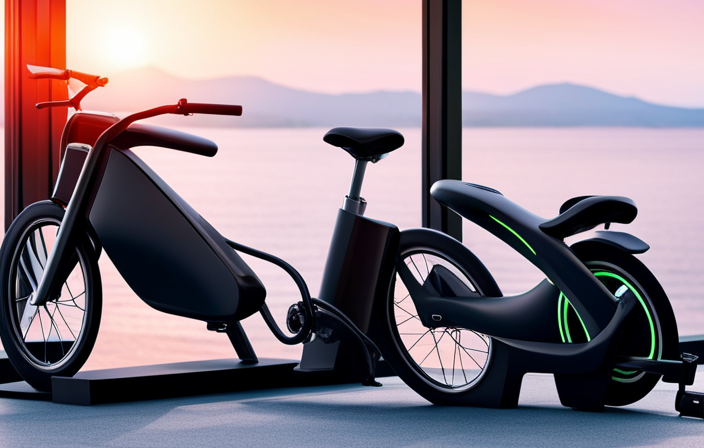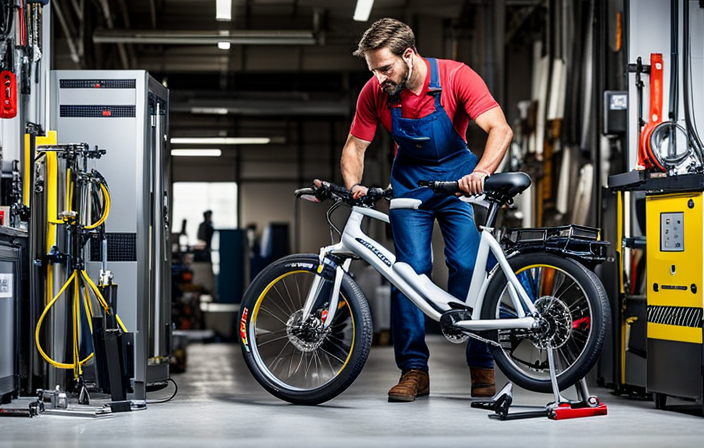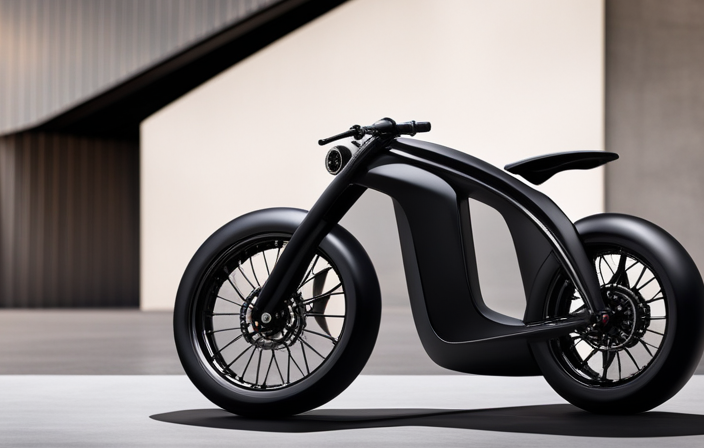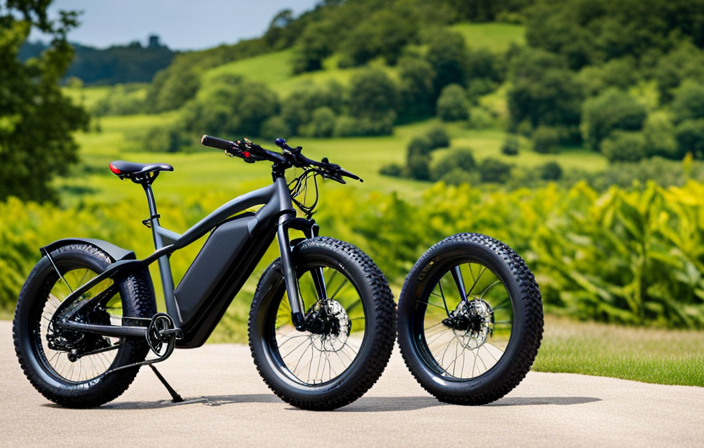I understand your concern: ‘Charging an electric bike must be costly, correct?’ However, let me assure you that it is not as expensive as you may believe. In this article, I will explain the different aspects that impact the cost of charging an electric bike and demonstrate how to calculate it.
I’ll also provide some tips to reduce charging costs and discuss the differences between home charging and public charging.
So, let’s dive into the world of electric bike charging and explore the future of this growing industry.
Key Takeaways
- The cost of charging an electric bike depends on factors such as electricity rates, battery capacity, frequency of charging, and the difference between home and public charging.
- Understanding kilowatt-hours (kWh) and calculating consumption is important for estimating the cost of charging.
- Using a cost calculator can help in accurately estimating the electricity costs, but it may have limitations and may not account for all variables.
- Tips to reduce charging costs include reducing charging time, using a higher power charger, charging when the battery level is low, and optimizing battery performance.
Factors Affecting the Cost of Charging an Electric Bike
If you’re wondering about the cost of charging an electric bike, there are several factors that can affect it.
One of the main factors is the electricity rate in your area. Different regions have varying electricity rates, so the cost of charging your electric bike will depend on where you live.
Additionally, the battery capacity of your electric bike plays a role in the cost. A larger battery will require more electricity to charge compared to a smaller one.
Another factor to consider is the frequency of charging. If you charge your electric bike frequently, it will have a greater impact on your electricity bill.
However, by calculating your savings from using an electric bike instead of a gas-powered vehicle, you may find that the cost of charging is minimal.
Now let’s delve into calculating the cost of charging your electric bike.
Calculating the Cost of Charging
Understanding kilowatt-hours (kWh) is crucial when it comes to calculating the cost of charging an electric bike. By comprehending kilowatt-hours, one can determine the amount of energy consumed during the charging process.
Estimating electricity costs is another important aspect. It allows for budgeting and understanding the financial implications of charging an electric bike. By estimating the electricity costs, one can plan and manage their expenses effectively.
Understanding Kilowatt-hours (kWh)
The cost of charging an electric bike depends on how many kilowatt-hours (kWh) it requires. Understanding kilowatt-hours is essential for calculating consumption accurately and understanding rates. Here are four key points to consider:
-
Kilowatt-hour (kWh): A unit of energy measurement that represents the amount of electricity consumed over time.
-
Calculating consumption: Multiply the power rating of the electric bike (in kilowatts) by the time it takes to charge (in hours) to determine the kilowatt-hours used.
-
Understanding rates: Different electricity providers have different rates for kilowatt-hours, so it’s important to check your provider’s pricing structure.
-
Energy-saving practices: Charging during off-peak hours or using a lower power setting can help reduce kilowatt-hour consumption.
Estimating Electricity Costs
To estimate your electricity expenses, simply multiply the power rating of your e-bike by the charging time to determine the kilowatt-hours used. This will give you an idea of your electricity consumption and help you compare charging costs.
Estimating the electricity consumption of your e-bike is essential in understanding the impact it has on your monthly budget. To assist you further, I have prepared a table that showcases the power ratings and charging times of different e-bike models, along with their estimated kilowatt-hours used. This table will provide you with a comprehensive view of the charging costs associated with these e-bikes.
By comparing these costs, you can make an informed decision about which e-bike is the most energy-efficient and cost-effective option for you.
Moving forward, let’s explore how you can use a cost calculator to get a more accurate estimate of your charging expenses.
Using a Cost Calculator
Let’s see how we can utilize a cost calculator to accurately estimate our charging expenses.
A cost calculator can be a valuable tool in determining the cost of charging our electric bike. One of the benefits of using a cost calculator is that it provides us with an accurate estimate based on our specific electricity rates and usage. By inputting this information, we can get a precise understanding of how much it will cost to charge our electric bike.
However, it is important to note that cost calculators have their limitations. They rely on the accuracy of the information we provide, and they may not account for variables such as fluctuations in electricity rates or the efficiency of our charging equipment.
Nevertheless, by using a cost calculator, we can gain valuable insights into our charging expenses and make informed decisions.
Now, let’s explore some tips to reduce our charging costs.
Tips to Reduce Charging Costs
One way you can save money on charging your electric bike is by avoiding peak hours. This is because electricity rates are typically higher during high-demand periods. To further reduce charging costs, here are some tips to consider:
-
Reducing Charging Time
-
Use a higher power charger to speed up the charging process.
-
Charge your electric bike when the battery level is low to avoid overcharging.
-
Optimizing Battery Performance
-
Keep your battery at an optimal temperature range for efficient charging.
-
Avoid frequent deep discharges as it can degrade battery performance.
By following these tips, you can minimize charging costs and maximize the lifespan of your electric bike’s battery.
As we move on to discussing public charging stations and costs, it’s important to consider the convenience and potential expenses associated with charging your electric bike outside of your home.
Public Charging Stations and Costs
When it comes to the availability of public charging stations, it’s crucial to consider the convenience and accessibility they offer.
Pay-per-use and subscription models are two common ways to access these stations, each with its own advantages and disadvantages.
Additionally, the availability of free charging options can also greatly impact the overall cost and convenience of charging an electric bike.
Availability of Public Charging Stations
You can easily find public charging stations for your electric bike. These stations offer convenient options for charging your electric bike when you are away from home.
Here are two scenarios that illustrate the availability of public charging stations:
-
Imagine riding your electric bike through the city. As you approach a bustling park, you notice a charging station nestled next to a row of benches. It is equipped with multiple charging ports, ready to accommodate various electric bike models. You park your bike, plug it in, and take a moment to relax on the nearby bench, knowing that your bike will be fully charged when you’re ready to continue your adventure.
-
Now picture yourself exploring a scenic coastal trail. As you pedal along, you come across a charging station strategically located near a picturesque viewpoint. This station blends seamlessly into the surroundings, with its sleek design and solar panels providing clean energy. You take advantage of this opportunity to charge your bike while taking in the breathtaking view.
Public charging stations offer the convenience and peace of mind that you can easily charge your electric bike while enjoying your surroundings. With these options available, you can confidently explore new places without worrying about running out of battery power.
Moving on to the next section, let’s delve into the intriguing world of pay-per-use and subscription models for electric bike charging.
Pay-per-use and Subscription Models
There’s a variety of payment options available for using and accessing charging stations for your e-bike. Whether you prefer a pay-as-you-go model or a membership plan, there’s something for everyone. Let’s take a closer look at the different options:
| Payment Option | Description |
|---|---|
| Pay-as-you-go | This option allows you to pay for each charging session as you use it. It’s a flexible choice for occasional e-bike riders who don’t need regular access to charging stations. |
| Membership Plans | These plans offer unlimited access to charging stations for a monthly or annual fee. They are ideal for frequent riders who rely on their e-bikes for daily transportation and need convenient and cost-effective charging options. |
Now that we’ve explored the pay-per-use and subscription models, let’s move on to the next section about free charging options.
Free Charging Options
If you’re looking for a budget-friendly option, consider exploring the various free charging options available for your e-bike.
One of the alternative charging methods that you can consider is solar power charging. Solar power charging involves harnessing the energy from the sun to charge your e-bike’s battery. This method is not only environmentally friendly but also cost-effective in the long run.
Many cities and towns now have public solar charging stations where you can conveniently charge your e-bike for free. These stations are equipped with solar panels that convert sunlight into electricity, which is then used to charge your e-bike.
By taking advantage of these free charging options, you can save money while also reducing your carbon footprint.
However, if you need a more consistent and reliable charging option, you may want to consider home charging or public charging.
Home Charging vs. Public Charging
When it comes to charging your electric bike, weighing the cost of home charging versus public charging is an important consideration. There are several benefits to home charging that make it a convenient and cost-effective option. First, you have complete control over the charging process, ensuring that your bike is always ready to go when you need it. Additionally, home charging allows you to take advantage of lower electricity rates during off-peak hours, saving you money in the long run. On the other hand, public charging has some drawbacks that should be taken into account. You may have to pay for charging at public stations, and these costs can add up over time. Furthermore, public charging stations may not always be readily available, causing inconvenience and potential delays.
| Home Charging Benefits | Public Charging Drawbacks |
|---|---|
| Control over charging process | Cost of charging at public stations |
| Lower electricity rates during off-peak hours | Inconvenience and potential delays |
| Convenient and always available | Limited availability of public charging stations |
| Cost-effective in the long run |
Considering these factors, home charging emerges as the more favorable option. Not only does it provide convenience and cost savings, but it also ensures that your electric bike is always ready to hit the road. Transitioning into the next section, let’s now explore the environmental benefits of electric bikes.
Environmental Benefits of Electric Bikes
To fully understand the environmental benefits of electric bikes, you should consider their impact on reducing carbon emissions. Electric bikes are a viable alternative to traditional gas-powered vehicles, as they produce zero tailpipe emissions. This means that by choosing to ride an electric bike, you are contributing to a significant reduction in carbon emissions, which helps combat climate change and improve air quality.
Additionally, many countries and cities have introduced electric bike subsidies to encourage their use, further incentivizing the adoption of this eco-friendly mode of transportation. By taking advantage of these subsidies, individuals can make a positive impact on the environment while also saving money.
Transitioning to the next section about charging etiquette and best practices, it is essential to understand how to efficiently charge your electric bike to maximize its environmental and economic benefits.
Charging Etiquette and Best Practices
Transitioning to the next section, it’s important to know how you can efficiently maximize the environmental and economic benefits of your electric bike by following charging etiquette and implementing best practices.
One key aspect to consider is charging time. It is recommended to charge the battery when it is below 20% to ensure a longer battery lifespan. Charging your electric bike for shorter periods throughout the day, rather than letting it completely drain before charging, can also help prolong the battery’s life.
Additionally, it’s important to use the charger provided by the manufacturer and avoid using third-party chargers, as they may not be compatible and could potentially damage the battery.
By adhering to these charging practices, you can ensure that your electric bike remains efficient and reliable.
Looking ahead, the future of electric bike charging holds exciting advancements, which we will explore in the next section.
The Future of Electric Bike Charging
One exciting advancement in the future of charging electric bikes is the development of wireless charging technology. This innovative solution eliminates the need for physical connections and offers a convenient and efficient way to recharge electric bikes.
With wireless charging, riders can simply park their bikes in designated areas and have them automatically start charging. This technology utilizes electromagnetic fields to transfer energy between a charging pad and the bike’s battery, ensuring a seamless and effortless charging experience.
As the demand for electric bikes continues to rise, wireless charging will play a crucial role in providing a hassle-free charging solution for riders. This future innovation has the potential to revolutionize the way we charge electric bikes, making it more accessible and convenient for everyone.
With wireless charging on the horizon, the next logical step is the development of a robust charging infrastructure to support this technology.
Charging Infrastructure Development
As the popularity of electric bikes continues to grow, it’s crucial to develop a robust charging infrastructure to meet the increasing demand. Charging infrastructure expansion is essential to ensure that electric bike users have convenient access to charging stations wherever they go. To support this, governments around the world are offering incentives to encourage the development of charging infrastructure. These incentives can include grants, tax breaks, and subsidies for businesses or individuals who invest in charging stations. By providing financial support, governments are playing a vital role in accelerating the growth of the charging infrastructure network. This will not only benefit electric bike users but also contribute to reducing carbon emissions and promoting sustainable transportation. In the table below, I have highlighted some examples of government incentives for charging infrastructure development.
| Country | Incentive |
|---|---|
| United States | Federal tax credits for charging station installation |
| Germany | Grants for businesses to set up charging stations |
| Netherlands | Subsidies for electric bike charging infrastructure |
| China | Funding for public charging stations in urban areas |
| Australia | Rebates for home charging station installation |
With these incentives in place, we can expect a significant expansion of the charging infrastructure network, making it even more convenient for electric bike users to charge their bikes on the go. This will ultimately contribute to the overall growth and adoption of electric bikes as a sustainable mode of transportation.
Transitioning into the next section, let’s now delve into the cost of charging an electric bike and explore the factors that influence it.
Conclusion: The Cost of Charging an Electric Bike
To wrap things up, you might be interested to know the factors that influence how expensive it is to power up your electric bike. Charging costs can vary depending on several factors, including:
- Electricity rates: The cost per kilowatt-hour (kWh) of electricity can vary depending on your location and the time of day you charge your bike.
- Battery capacity: The size of your electric bike’s battery will determine how much energy it can store and how long it takes to charge fully.
- Charging speed: The charging speed of your electric bike will affect how quickly you can top up the battery and how much energy you consume in the process.
- Charging infrastructure: The availability and accessibility of charging stations in your area can impact the convenience and cost of charging your electric bike.
To reduce charging costs, consider these tips:
- Charge during off-peak hours when electricity rates are lower.
- Opt for a bike with a larger battery capacity for longer rides and fewer charging cycles.
- Use a slower charging speed to minimize energy consumption.
- Take advantage of public charging stations to avoid high home electricity rates.
Frequently Asked Questions
Are there any government incentives or rebates available for electric bike charging?
Yes, there are government incentives and rebates available for electric bike charging. These incentives aim to promote the use of electric bikes and make charging more affordable for users.
Can I use a regular power outlet at home to charge my electric bike?
Using a regular power outlet at home to charge my electric bike is like a double-edged sword. While it offers convenience, using an extension cord may lead to slower charging and potential safety hazards.
Are there any additional costs associated with using public charging stations?
There are additional costs associated with using public charging stations. While availability may vary, the cost of home charging is typically lower. It is important to consider these factors when deciding where to charge your electric bike.
How long does it typically take to fully charge an electric bike?
Charging an electric bike is like watching a clock tick, with charging time varying based on factors like battery capacity and charging speed. Factors affecting electric bike charging time include battery size and type, charger power, and the initial charge level.
Is it possible to charge an electric bike using solar power?
Yes, it is possible to charge an electric bike using solar power. The charging efficiency may vary depending on factors like sunlight intensity and panel capacity. This method has a positive environmental impact, reducing reliance on fossil fuels.
Conclusion
In conclusion, after carefully analyzing the various factors affecting the cost of charging an electric bike, it becomes clear that this charging process is not as simple as it may seem.
Just like a web of intricate connections, the cost of charging is influenced by factors such as electricity rates, battery capacity, and charging duration.
By understanding these factors and implementing tips to reduce charging costs, one can navigate this tangled web with ease.
As charging infrastructure continues to develop, the future holds great promise for a more convenient and cost-effective charging experience.









